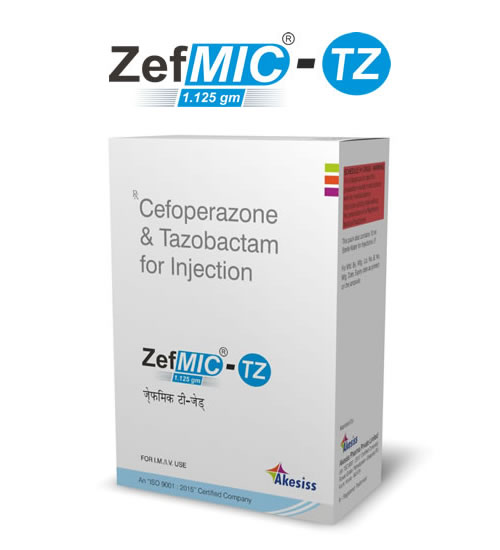COMPOSITION:
Each vial contains:
Cefoperazone Sodium IP
Eq. to Cefoperazone …………………………………………………. 1000mg
Tazobactam Sodium
Eq. to Tazobactam ……………………………………………………. 125 mg
PHARMACEUTICAL FORM: Powder for injection.
DESCRIPTION:
The combination of Cefoperazone (3rd generation Cephalosporin) and Tazobactam (beta-lactamase inhibitor) provides a solution for treatment of bacterial infections caused by betalactam resistant pathogens.
MECHANISM OF ACTION:
Cefoperazone is bactericidal in action. The antibacterial activity of the drug results from inhibition of nucleopeptide synthesis in the bacterial cell wall.
Tazobactam has little, clinically relevant activity against bacteria due to its reduced affinity to penicillin binding proteins. It is a â-lactamase inhibitor of the Richmond-Sykes class III penicillinases and cephalosporinases. It does not induce chromosomally mediated â-lactamases.
SPECTRUM:
Cefoperazone is a broad spectrum antibiotic. Cefoperazone is generally less active in vitro against susceptible staphylococci than a first generation cephalosporin but has expanded spectrum of activity against gram negative bacteria. Cefoperazone with tazobactam is a useful combination for the treatment of infection due to extended-spectrum beta-lactamase (ESBL) producing organisms.
The following bacteria are sensitive to cefoperazone and tazobactam combination:
Gram-positive Aerobic Bacteria:
Streptococcus pyogenes (Group A beta-hemolytic streptococci)
Streptococcus agalactiae (Group B beta-hemolytic streptococci)
Streptococcus viridans, Streptococcus pneumonia, Streptococcus faecium and Streptococcus durans, and Enterococcus faecalis.
Gram-negative Aerobic Bacteria:
Citrobacter species (Citrobacter diversus, Citrobacter freundi)
Enterobacter species (Enterobacter aerogens, Enterobacter cloacae)
Escherichia coli, Klebsiella species (Klebsiella oxytoca, Klebsiella pneumonia)
Morganella morganii, Proteus mirabilis, Proteus vulgaris,
Providencia, Salmonella, Shigella, Yersinia enterocolitica,
Pseudomonas aeruginosa, and certain other Pseudomonas species,
Haemophilus influenzae and Haemophilus parainfluenzae, Neisseria
gonorrhoeae including penicillinase producing strains, Neisseria
meningitides, and Bordetella pertussis.
Anaerobic Bacteria:
Gram-negative bacilli (including Bacteroides fragilis, other
Bacteroides species, and Fusobacterium species).
Gram-positive and gram-negative cocci (including Peptococcus,
Peptostreptococcus, and Veillonella species).
Gram-positive bacilli (including Clostridium and Eubacterium).
PHARMACOKINETIC PROPERTIES:
Absorption:
Cefoperazone is given parenterally as the sodium salt. Cefoperazone and tazobactam is not appreciably absorbed from the gastrointestinal tract. On intramuscular administration of cefoperazone (1 or 2 g) peak plasma concentrations were attained ranging from 65 to 97 micrograms/mL after 1 to 2 hours, whereas after a dose of 2 g of tazobactam, peak plasma concentrations ranged from 30 to and tazobactam is 1 hour, but may be prolonged in neonates, in patients with hepatic or biliary-tract disease, severe renal impairment and end stage renal disease, and in patients with both renal and hepatic impairment. Cefoperazone is 82% to 93% bound to plasma proteins, depending on the concentration and 20% in case of tazobactam.
Distribution:
Cefoperazone and tazobactam are widely distributed in body tissues and fluids, although penetration into the cerebrospinal fluid (CSF) is generally poor. The CSF concentration of cefoperazone is generally higher in patients with inflammation to the meninges. It crosses the placenta, and low concentrations have been detected in breast milk.
Metabolism and Excretion:
Cefoperazone is excreted mainly in the bile where it rapidly achieves high concentrations. Up to 20% of tazobactam is also found to be excreted through bile. About 60% to 80% of tazobactam is excreted unchanged in the urine by glomerular filtration and tubular secretion within 24 hours. Up to 30% of cefoperazone is excreted unchanged in the urine within 12 to 24 hours; this proportion may be increased in patients with hepatic or biliary disease. Cefoperazone A, a degradation product less active than cefoperazone, has been found in vivo, rarely. Plasma concentrations of tazobactam are enhanced by probenecid. Tazobactam can be removed by hemodialysis. 40 micrograms/mL within 30 to 50 minutes. The pharmacokinetics of tazobactam is reported to be nonlinear and dose-dependent. The plasma half-life of cefoperazone is about 2 hours.
DOSAGE AND ADMINISTRATION:
Cefoperazone and Tazobactam are preferably administered by IV infusion but may also be given by deep IM injection. An IV infusion should be given slowly over 15 to 30 minutes. The usual adult dosage of cefoperazone and tazobactam is 2 to 4 g daily given in equally divided doses every 12 hours (in terms of cefoperazone).


